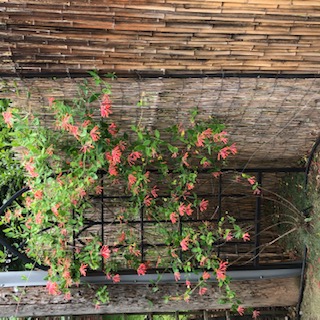Colorful, versatile, whimsical & easy!

Gardening with native plants is magical. With a few simple plantings, your garden can come alive. One plant will do this all on its own: trumpet honeysuckle (Lonicera sempervirens). Hummingbirds, bees and butterflies alike seek out this vine.
Honeysuckle vines bloom with a huge flush of flowers in late spring. Vines, particularly those in sunnier locations, will continue to flower through summer, though not typically with the large numbers of flowers you get in spring. Come fall, the vines produce luminous red berries devoured by many birds. Foliage turns yellow. In many areas, trumpet honeysuckle is semi-evergreen with foliage lasting through December and growing again in early March.
Growing
Trumpet honeysuckle grows in part shade to full sun. To maximize flowers, full sun is best. These woody vines are drought tolerant and grow in a range of soils. As with any plant, when newly planted, water regularly. Once it is established, it will be fine on its own. They grow anywhere from 8 to 20 feet tall and wide if you let them. They are simply stunning and so easy.
Honeysuckle climbs and meanders and will wind itself around most any structure. If you want to train it to cover a post, fence or arbor, it's very easy. Once it's tall enough to reach your intended location, use a bit of string to loosely tie it to its structure. That will usually be enough to guide the growth.
While this vine grows up and along structures, it is nothing like the invasive Japanese honeysuckle vine which will actually grow as a large shrub or tree if left to its own devices. Native honeysuckle is much more restrained and manageable.
This vine can be pruned at anytime if you want to curb its growth. As recommended for most plants, it's probably best not to cut it back by more than third at a time. And if you prune in late winter or early spring right before it blooms, you may prune out flowers. That said, it's really not necessary to prune this at all unless you are trying to coax it into a neater form. If you want foliage and flowers atop a fence or a trellis, you can easily prune out the side growth so that all of the foliage is toward the top.
The Varieties

The common trumpet honeysuckle is nearly evergreen and blooms frequently through the summer. It's planted here along our low fence.

Another popular type, trumpet honeysuckle 'Major Wheeler' (Lonicera sempervirens "Major Wheeler') has flowers redder in color and, in our garden, bloom a week to two earlier than common trumpet honeysuckle. The foliage also has a more dusky purple color in early spring. Major Wheeler does not seem to have as many blooms through the rest of the summer.
There are two other widely available coral colored varieties. Trumpet honeysuckle 'Magnifica'
(Lonicera sempervirens 'Magnifica') grows to just 7 feet tall and wide. If you are looking for a smaller vine, this may be a good choice. Trumpet honeysuckle 'Blanche Sandman' (Lonicera sempervirens 'Blanche Sandman') has orange red flowers
Trumpet honeysuckle 'John Clayton' (Lonicera sempervirens f. sulphurea "John Clayton') is the variety with yellow flowers. The Missouri Botanical Garden notes this variety was found growing in an old Virginia church yard.
Garden Design
These are very versatile vines. They can grow along a fence informally or pruned to be tidier. They look great on a trellis or even in a container. Bird house poles look great covered with honeysuckle. Honeysuckle also makes a great cover for all things unsightly.
Sourcing
Trumpet honeysuckle vines are readily available at native plant nurseries and often at garden centers. They are also available on-line. Plant More Natives has all five types available by mail here:
I recently ordered from Plant More Natives for the first time and was totally impressed by the robustness of the plants and loved that they were shipped so quickly and efficiently with no plastic pots -- less plastic waste. Nuts for natives has no financial connection to any business - just promoting native plants.
Whether you add your first honeysuckle or your fifth, enjoy the magic!

































Kaiser OTC benefits provide members with discounts on over-the-counter medications, vitamins, and health essentials, promoting better health management and cost-effective wellness solutions.
Obituaries near me help you find recent death notices, providing information about funeral services, memorials, and tributes for loved ones in your area.
is traveluro legit? Many users have had mixed experiences with the platform, so it's important to read reviews and verify deals before booking.